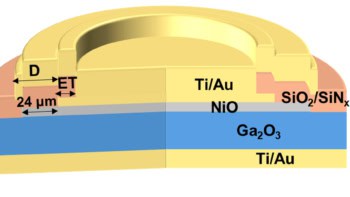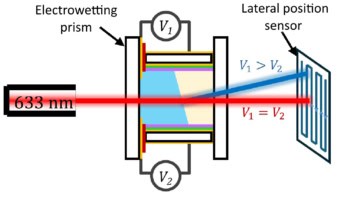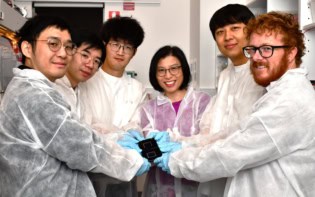
Physicists have used holography to reliably do to electrons what they can already do to photons – twist the particle wavefronts to create beams with vortices at their centre. The researchers say that such vortex electron beams could reveal the magnetic properties of materials at the atomic scale and be used to build structures atom by atom.
Since at least the early 1990s, physicists have been able to produce light beams in which the photons not only have spin angular momentum – in other words, the wave is circularly polarized – but also orbital angular momentum. This means that the wavefront is made to spiral around the direction of propagation, generating vortices around the centre of the beam where the intensity of the wave is zero and its phase is undefined. These beams have been used to drive microscopic motors and have also served as “optical tweezers” that capture particles such as biological cells in their vortex and then move them around.
Earlier this year Masaya Uchida and Akira Tonomura of the RIKEN Institute in Japan showed how to produce vortex beams of electrons. They did this by directing electron beams around a tiny spiral-staircase like structure made from extremely thin slices of graphite. However, the technique is difficult to reproduce because it involves a painstaking search for the staircases within the graphite, rather than systematically producing such structures. The structures are also vulnerable to contamination and damage.
No object required
Jo Verbeeck of the University of Antwerp in Belgium and colleagues from Antwerp and the Technical University in Vienna say they have overcome this problem by instead making electron vortex beams using holograms. The technique is similar to that used to make optical holograms, in which light is reflected off the object and then made to interfere with a reference beam, creating a fringe pattern on a photographic plate that when illuminated by the original reference beam generates a three-dimensional image of the object. The crucial difference in this case, however, is that no object is required.
Computer software is used to calculate the fringe pattern that would be created by the interference of the object beam – the vortex beam – with a reference beam from a standard electron microscope. Then they use a focused beam of ions to carve out the pattern calculated by the computer in a thin foil mask made from platinum. Shining the reference beam through the mask then generates the vortex beam.
“I don’t see a good reason why this couldn’t have been done 10 years ago,” says Verbeeck. “I’ve been walking around with these ideas for three or four years, and it was only about six months ago that I actually sat down and thought about how to put them into practice. We then produced the beams the first time we tried.”
Easy to make
Verbeeck points out that the graphite slices produced by Uchida and Tonomura must have a thickness of the order of nanometres, a precision dictated by the need to directly manipulate the phase of the electron beam. In contrast, he says, the features in his group’s fringe patterns need be no smaller than microns, with the upper limit in the case determined by the need to keep a certain minimum distance between the vortex beams that emerge from the mask. Such micron resolution is relatively easily achieved using ion beams, as illustrated by the very close match between the shape of the image of the vortex beams obtained by the group experimentally with that calculated in the simulations beforehand (see figure above). “Anyone with the right equipment can make these masks and reproduce the experiment” he claims.
One of the main applications of this research, says Verbeeck, is likely to be the investigation of magnetism at very small scales. He and his colleagues have shown that electron vortex beams could provide information about magnetic materials because they generate very slightly different spectra of these materials depending on whether the wavefront of the beams spiral in a clockwise or anti-clockwise sense. And, because electrons typically have a much smaller wavelength than photons, these beams could potentially be used to study a material’s magnetism atom by atom, allowing, for example, the development of improved spintronic devices. According to Verbeeck, electron vortex beams might also be used to move single atoms and molecules around and permit the assembly of objects such as nanoscale motors from the bottom up.
Uchida agrees that the latest research represents a “very practical method” to make electron vortex beams, which he says will accelerate the use of these beams in areas of basic research such as quantum mechanics and particle physics. Franco Nori of the University of Michigan in the US and RIKEN in Japan also believes that the masks produced by Verbeeck’s team “open an avenue” for the practical use of electron vortex beams. He says they may be particularly useful in condensed-matter physics, as well as electron microscopy, but cautions that it is often difficult to predict the applications of a particular piece of research.
The work is reported in Nature 467 301.



